Why Stein’s Gate’s Time Travel Is Perfect

Your changes have been saved
Email Is sent
Please verify your email address.
You’ve reached your account maximum for followed topics.

One Piece: 5 Strong Attacks That Never End Fights
Dragon ball: 8 weakest saiyan characters, ranked, an interview with brina palencia and j michael tatum, the english vas of ciel phantomhive and sebastian from black butler.
This article contains spoilers for the Steins; Gate anime and the visual novel. Steins; Gate is one of the most acclaimed animes of the 2010s for a number of reasons. A great character development, cliffhangers at every turn, a compelling story and a unique protagonist, the 2011 adaption from the visual novel became a classic almost immediately. Nowadays, the anime is even more known than the original game in perhaps one of the most successful adaptions, if not the most, when a videogame is the original source. But if there is something that sets Steins;Gate apart it's the attention to detail when building a story based on time travel.
Set in Akihabara, Tokyo, the show follows around Rintaro Okabe , a picturesque character that keeps calling himself a "mad scientist". With his friends Mayuri Shiina and Daru Hashida, he founded the Future Gadget Laboratory in which they pursue a great invention that will change their lives forever. And that's exactly what happened when Rintaro was attending a time-travel conference. After one of the lectures he found the dead body of Kurisu Makise, a famous scientist, while wandering through aisles of the building. He then sent a message to Daru, but accidentally, the message was sent to the past with his cell phone-operated microwave oven. That alone reversed Kurisu's death and gave birth to the D-mails, messages to the past that have the power to change the present, but with only Rintaro remembering the timeline before the message was sent.
RELATED: Where The Steins;Gate 0 Timeline Fits Into The Story
Time-Travel in Steins; Gate Compared to Other Anime
The use and explanation of this D-mails might seem dubious at first, but in every episode they will go into deeper details and even giving a general explanation in current accepted time-travel theories. As Kurisu states, there are 11 theories that have settled in the scientific community (they talk about all of them in the game), but from those eleven, Steins;Gate focuses on the Black Hole theory , specifically, traveling through a Kerr-Black Hole.
The mentioned microwave oven can create a miniature Kerr-Black Hole and send data through it effectively going to the past, and with that, changing to a world-line in which a certain event occurs differently. The show itself tries to explain how this theory works multiple times, usually with Kurisu as the teacher. Also, they take into consideration other well-known theories for the consequences of time-travel like the Butterfly Effect theory or the Many-Worlds Interpretation theory. No other anime has tried this hard to have a proven background on how exactly the time-travel, one key component of the plot, works.
To put in perspective, time-travel is a common tool in anime, but it's rarely clarified, as most of the time the occurrence of leaping through time is taken for granted. That is the case in Erased and Tokyo Revengers where they simply never say clearly how their protagonist can do it. Both are pretty similar in how they occupy their younger-self body in order to change an event related to them in the past, and to do so, they have certain rules to follow. However, they lack a basis or detailed idea on how this can possibly happen as this "power" seems like a natural ability or something incomprehensible.
RELATED: The Ending to Steins;Gate: Load Region of Déjà Vu, Explained
In Steins; Gate , the Reading Steiner would be this natural ability only possessed by the main character. This ability allows him to remember every world-line he has been a part of, meanwhile everybody else is only aware of the word-line they are in at the moment. Nonetheless, in the end they also explain it and show that everybody has it, with the difference that for the rest it might seem as vague dreams. That's because Rintaro is the only one doing the actual jumps, he is not changing the past, instead he is making himself jump between world-lines.
Another similar example to Erased and Tokyo Revengers would be Your Name , the beloved film by Makoto Shinkai . Once again, the two main characters find themselves traveling to a different time, one to the future and one to the past, while they also exchange their bodies temporarily. Some mentions to a ritual in Mitsuha's family and the meteorite incident is all the information that was given about how they were suddenly time-traveling. These examples bring up a trend, more often than not, stories that include time-travel have a number of holes or missing pieces that the spectator is expected to ignore, because at the end of the day, it's something far from reality and attached to our imagination. Yet, with how far time-travel theories have gone and how important meddling with time and space is for the collective worldview, a show closer to reality should be a possibility, that was the mindset for creating Steins; Gate .
What Makes It Special
The idea to write a story using real theories on the matter might feel overwhelming at first, and it certainly did in the visual novel. When the player is thrown a huge amount of information about time-travel theories and basic physics knowledge in black holes, wormholes, and so on, it can be difficult to process. The adaption, on the other hand, did a great job digesting and displaying it with a much better tempo. But what truly makes it work is Rintaro's attitude and how he changes from just trying to help his friends with their to wishes to trying to fix all the consequences, upon threat of death or imprisonment. All while taking into consideration extended theories on the possible outcomes of time travel.
They don't throw all that information regardless of what it does the story, they write the whole story about it in a way they can still use more typical character development and relationships. What starts being a shockingly detailed sci-fi ends up being a romantic comedy, a thriller and the old tale of friendship and working together, everything at the same time. Furthermore, incorporating real life topics to their world, like the mention of John Titor or the evil SERN, clearly based on CERN, creates a more relatable environment, different from traditional science fiction or even some animes.
Although, to be fair, the Future Gadget No. 8, the PhoneWave (Name subject to change), the one used for the D-mails, is much more grounded or realistic (if that word applies in this case) than the Time Leap Machine or the actual time machine, both of them seemingly impossible and closer to the science-fiction narrative . Still, the same rules are valid and apply to them, and by the point they are presented the image of the show has completely changed and turned into that mixed of genres that makes it so unique. A time loop paradox at the end completes an idyllic use of time-travel as a narrative tool and gives a closure some consider fan pandering. Regardless of that, Steins;Gate puts the study of time at center of the plot, instead of using time-travel as a mere utensil to move from one thing to another, they wrote a story for it, and a superb one, and that's what sets it apart from other similar shows or films.
MORE: The Best Sci-Fi Anime To Watch If You Love Steins;Gate
Why ‘Steins;Gate’ Has the Best Use of Time Travel in Anime

Your changes have been saved
Email Is sent
Please verify your email address.
You’ve reached your account maximum for followed topics.
‘One Piece’ Arcs in Order: How To Catch up to the ‘Egghead Island’ Arc
Collect the ton’s biggest names with new ‘bridgerton’ funko pops, this 'peacemaker' villain is coming back for season 2.
Time travel is not an underused concept in anime. Multiple shows and films have tried to pull it off to differing degrees of success. Series like Erased and Tokyo Revengers and films like Your Name and The Girl Who Leapt Through Time are some well-known examples. More often than not, the ability to time travel in anime is a tool for characters to reach the necessary plot points, and in most cases that is, like a soft magic system, left largely unexplained. When involving this particular narrative device, it is easy for a story to risk being punctured by inconsistencies and paradoxes if not meticulously thought through. Among all the Japanese aime titles that feature time traveling, one stands out among them as the quintessential paragon of the subgenre: Steins;Gate .
No anime has as successfully and thoroughly weaved time travel into its plot. Watching the 2011 anime adaptation by White Fox Studio, or playing the 2009 visual novel that inspired it, is guaranteed to blow one’s mind. In Steins;Gate , time travel is not simply one of many elements that make up its plot, instead, understanding the act of jumping to the past and its ramifications is at the core of the story. Steins;Gate goes above and beyond to fill in as many loopholes as it can while laying out the inner workings of the time-travel theories it is based upon. These are a combination of the butterfly effect theory, the many-worlds interpretation theory, and the black hole theory. Hence, it distinguishes itself from other series like Erased and Tokyo Revengers , wherein the protagonist’s ability to leap back to the past is purposefully ambiguous with no real-life theory to base it upon.
RELATED: The 10 Coolest Anime Power Systems, Ranked
In addition to its theories, Steins;Gate incorporates multiple elements of popular culture. One of the most relevant to the overall story is the self-proclaimed time traveler John Titor’s unbelievable claims that circulated the internet in the year 2000. The extensive worldbuilding details are a testament to the painstaking research the creative teams from 5pb. and Nitroplus conducted in order to design this intricate narrative. All these particularities serve to fill the story with depth, which makes it, in spite of its science-fiction nature, incredibly plausible.
Quite often, time-traveling stories are permeated with holes that we must ignore for the sake of suspending our disbelief. Steins;Gate does not count on the viewers’ suspension of disbelief to carry them mindlessly through the sci-fi elements, on the contrary, it minimizes this disbelief because it does not shy away from the complexities of writing about time travel. Although the visual novel, due to its inherent characteristics, is able to go into far more detail and explore its topics more in-depth, the White Fox adaptation remained sufficiently faithful to the source material while making the heaps of dense information easily digestible to viewers.
In this way, Steins;Gate manages to bypass the possible problems with the density of its subject matter, which is precisely why the series appears slow to pick up the pace. If there is one fair criticism to have of the anime is that it has a slow start, slower than usual for the medium. But that does not mean that nothing happens, on the contrary, a lot happens in each episode, the difference is that the actions taken in the first couple of episodes only get their full blow back almost halfway through the series. Steins;Gate takes its time to develop the characters, their relationships, the setting, and gradually lays out the foundation that will lead to the chain of mind-boggling plot twists that are thrown at us later on. But above all else, one aspect that speaks to the brilliance of Steins;Gate is its thematic consistency, which also translates itself into the character arcs that unfold before our eyes.
Rintaro Okabe’s ( Mamoru Miyano ) experience mirrors the viewers’ in the way in which he goes from being heedlessly complacent to being hit with the consequences of his meddling with time, to becoming serious in the pursuit of ascertaining the steps required to fix them. We, too, realize just how much of a pickle the lab members are in when the possibility of imprisonment and even death suddenly stare them in the face. The wish to amend past mistakes and unfortunate events is something very human and that makes it so that we empathize with Okabe’s actions as he, unaware of the impending fallout, uses Future Gadget No. 8, the PhoneWave (Name subject to change), to change the past according to his friends’ wishes. However, this sends him to the Alpha Worldline, an attractor field in which not only does his childhood friend Mayuri Shiina ( Kana Hanazawa ) die no matter what, due to her demise being the converging point, but it also leads to a bleak future dystopia. Steins;Gate confronts both the protagonist and the viewers with the repercussions of having the power to mess with the past.
On a larger scale, the credible sci-fi elements allude to present-day “what ifs” that stimulate our critical thinking over the subject. Steins;Gate distinguishes itself from the other anime titles mentioned in this article because it is not afraid to dig deep into this complicated subject while raising hefty questions associated with the aftereffects of tampering with time. Although The Girl Who Leapt Through Time also deals with the desire to shape the past to our liking and the unforeseen consequences of doing so, it does so from a non-scientific perspective that does not make as poignant a point as Steins;Gate .
The use of time travel in Steins;Gate is not the constant Deus Ex-Machina that is there to aid the protagonist reach their desirable reality, like in Erased or Tokyo Revengers , or exists mostly for the sake of the central plot twist, like in Your Name . Instead, it ties into all elements of the narrative. Starting on Episode 12 and due to his interfering with the past, Rintaro is sent through a series of traumatic events that follow a Groundhog Day loop that only he remembers thanks to his Reading Steiner ability or, in common terms, what we can understand to be a ripple effect-proof memory. Thus, the plot follows a deconstruction of the trope Set Right What Once Went Wrong. Unlike Tokyo Revengers and Erased wherein the protagonist must find the solution in the past to amend the present, Rintaro is both the cause and the solution for most of the mistakes made throughout the series, all the while being faced with an inescapable moral dilemma that challenges his scientific idealism.
On top of being a gripping journey that fully takes off halfway through the series, Steins;Gate closes its story with a near-perfect ending. First, the ending is the beginning. This revelation alone is astonishing enough but for it to work, Steins;Gate incorporated the bootstrap paradox into its plot. However, because time travel in Steins;Gate comprises the many-worlds interpretation theory, the series is capable of avoiding inconsistency by finding a loophole in the seemingly closed loop which in turn leads to the true ending of the visual novel and the only ending of the anime.
In both mediums, Rintaro manages to find the desirable world line, “Steins Gate”, when he tricks out time by making it appear like Kurisu Makise ( Asami Imai ) was murdered, so his past self would unwittingly be guided to follow on the events of the beginning creating a perfect loop with one perfect resolution. And thus, past and future Rintaro together achieve the ideal divergence number of 1.048596, rewarding him and us viewers with a deserved happy ending after all the heartache. The follow-up Steins;Gate 0 , builds upon this ending but what makes it so unique is that it does not do so as a sequel. It covers some of the holes its predecessor left open, giving viewers the context as to how Beta-worldline Rintaro managed to reach the solution to “Steins Gate”, and for that alone, it is worthy of mention.
In Steins;Gate , every step and misstep taken along the way was meaningful, which speaks volumes about how well-thought-out the plot is. Admittedly, the science behind the series has its issues. A scientist with a comprehensive understanding of quantum mechanics would be able to tell exactly in which ways it is flawed. At the end of the day, it is fictionalized science, we need to suspend our disbelief and accept, for instance, that a microwave can somehow become a time machine. Nonetheless, Steins;Gate goes to commendable lengths to seem plausible in its implausibility.
What truly makes it stand out amongst other titles of the same subgenre of sci-fi, is its airtight thematic cohesion. Compared to other anime that only use time travel as a device to get from one plot point to another, the series is concerned with the essence of time itself and speculates what would happen if the power to bend it fell into human hands. This is perfectly embodied in Rintaro’s character arc which also corresponds to the main moral lesson of the series: Trying to reject the past and live without consequences is impossible, whereas, the future is unknowable and therefore full of possibility. We draft our own path, it’s up to us to find the route to “Steins Gate” in our present reality.
13 years later, the most cerebral time-travel game ever made still holds up
A deadly mind game.
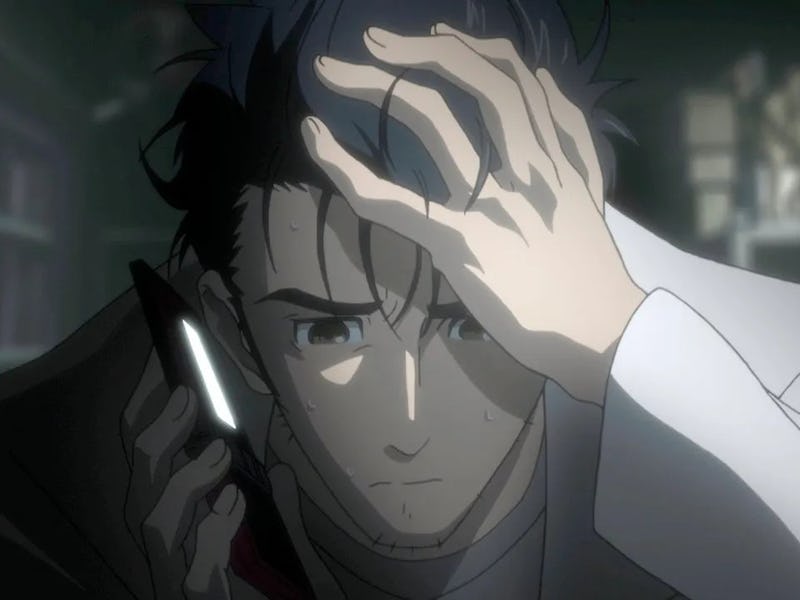
Video games have explored time travel for decades now, from the mind-bending mechanics of Majora’s Mask to the eerily static shootouts of Quantum Break . While the gimmick often makes for a memorable experience, very few stories examine the mental and emotional impacts that traveling through time might have on a person. That’s exactly where Steins;Gate comes in, with a phenomenal story that puts the humanity of its main character at the center of all its timey-wimey shenanigans.
While the award-winning anime of Steins;Gate has been more widely embraced, the series is actually based on a visual novel of the same name, first released in Japan back in 2009. The two share the same story, but the anime condenses and elevates the presentation of the original interactive experience. The game was developed by 5pb (now known as Mages Inc.), a studio with a long history of other notable visual novels like Chaos;Head , Corpse Party , and Robotics;Notes .
Steins;Gate focuses on Rintaro Okabe, a self-proclaimed “mad scientist” that runs the Future Gadget Laboratory out of his one-bedroom apartment. Despite his brilliance, Okabe is a social reject who’s failed to find success in life — until he accidentally stumbles upon the secret to time travel.
THE RULES OF TIME TRAVEL is an Inverse special issue exploring the evolution of science fiction's most imaginative sub-genre. From Marty McFly to Avengers: Endgame .
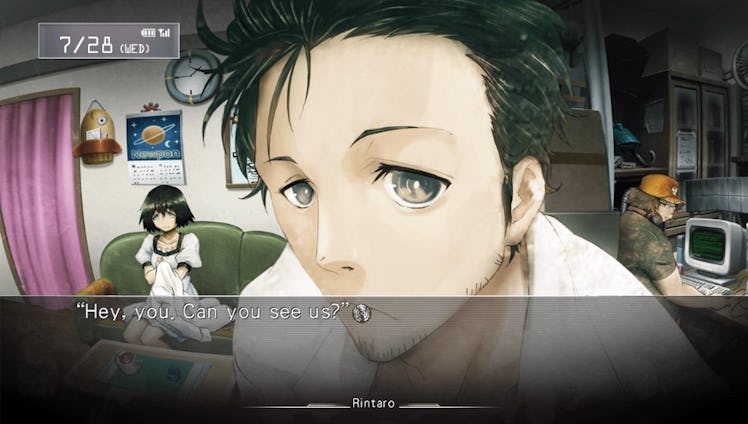
Steins Gate’s characters feel like anime stereotypes at first, but the story quickly subverts those tropes.
Through a wild experiment using bananas and a microwave, Okabe figures out a way to send text messages into the past, thus influencing his past self and the timeline. He uses this newfound power to save a brilliant scientist name Makise Kurisu, and things spiral completely out of control from there as the group discovers a way to send someone’s consciousness back in time.
“Even the most innocuous interactions become major plot points.”
What’s so fascinating about Steins;Gate is that it’s truly a story about time travel, not just a story that features time travel. The story is a slow burn that builds up to a thrilling climax before completely pulling the rug out from players with a wild endgame twist. As Okabe uses his D-Mail (Delorean Mail) to influence the past, things start becoming more thorny, as complications he could never have predicted begin to spring up like so many hydra’s heads.
Without wading too much into spoilerville, by changing the past and altering the timeline, Okabe creates a line of causality that all but guarantees the demise of someone he loves. From there, much of Steins;Gate ’s story is a desperate dash through time, as Okabe repeatedly attempts to prevent this horrible inevitability. As the story slowly unfolds, so too does Okabe’s psyche, as he’s subjected to seeing his friend perish over and over. Before long, Okabe can’t remember what he’s changed and what’s true to the original timeline, and his grasp on reality grows more and more shaky.
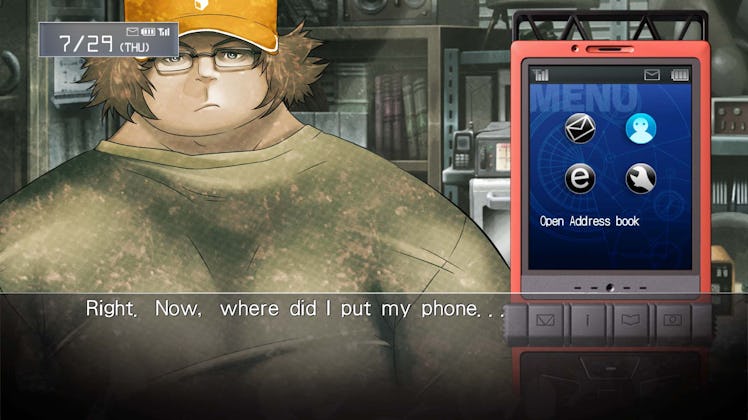
Steins Gate is pretty light on gameplay, with only a few interactive elements in terms of choices and using Okabe’s phone.
Steins;Gate is filled with fascinating characters, but Okabe is at the heart of everything. Both the game and show masterfully balance humor and tension, taking the audience on a rollercoaster of emotions. One second you’re laughing at Okabe’s strange obsession with Dr. Pepper, and the next you’re witnessing government conspiracies and horrific crimes. Time travel is, of course, central to the story, but it’s more of a vessel for unpacking the eccentricities of the main cast and helping them confront the trauma they’ve faced.
“One of the best time-travel stories ever told.”
Most time travel stories come with their own fair share of plotholes — it’s a natural side effect of the genre. But Steins;Gate manages to tie everything together better than most. The level of thought and care put into the story are startling, and a steady trickle of revelations means even the most innocuous interactions become major plot points.
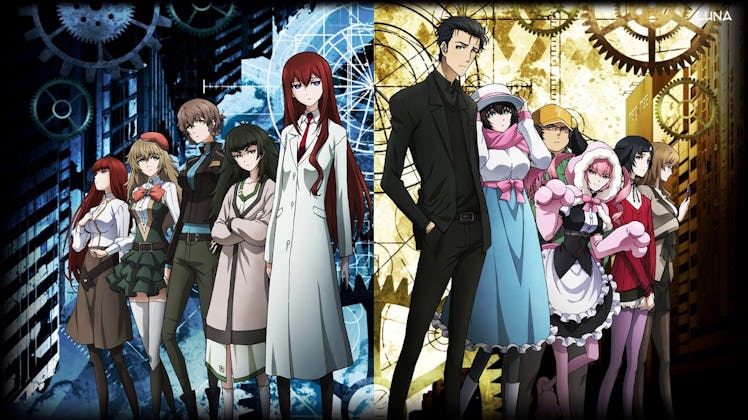
A sequel called Steins Gate 0 was released in 2015, and also has an anime adaption. The story follows one of the worldlines created when Okabe changed the past.
As a visual novel, Steins;Gate is light on gameplay, as most of your time is spent reading and solving some light puzzles. The game features a wealth of choices that can alter how the story plays out, which is obviously a contrast to the mainline story told by the anime. The gameplay experience is really just a vessel to tell the story, and luckily there are multiple ways to experience Steins Gate , depending on what gels with you the most.
Both the original game and anime are fantastic, but if you want something that falls in the middle you can play Steins;Gate Elite , which replaces the hand-drawn scenes of the original game with fully-animated versions from the anime.
Steins;Gate is the rare experience that questions why we’re so obsessed with time travel and changing the past. Most people say they would change the past if they could, but what effect would that really have on you as a person, and the reality you see? This is an utterly engrossing story about the nature of the human mind, and one of the best time-travel stories ever told.
The original Steins;Gate is available for purchase on PC, Xbox 360, PS3, and PS4. The Steins;Gate Elite remake is available for purchase on PS4, Switch, PC, and Vita.
- Video Games
Steins;Gate: 10 Things You Never Knew About This Time Travel Anime

Your changes have been saved
Email Is sent
Please verify your email address.
You’ve reached your account maximum for followed topics.
A Rejected Goku Design Reveals That Dragon Ball's Hero Almost Had a Completely Different Weapon
10 things bleach thousand year blood war anime must improve on the manga, 10 darkest isekai anime of all time, ranked.
In Steins; Gate the eccentric student Rintaro Okabe accidentally emails himself a week into his past with his wacky microwave-o-phone invention. Time-travel experiments ensue. The 25-episode anime was a classic in 2011, and there's an abundance of trivia to emphasize the anime’s lasting quality.
RELATED: Steins; Gate: 10 Reasons It's A Must-Watch Anime Series
The story’s adventures in quantum mechanics led Okabe and his lab of misfits down a rabbit hole of discoveries, conundrums, moral quandaries, and sacrifices in their quests. What follows is some insight into the details you never knew.
10 For Nerd Eyes Only
The series has several nods to things that only the geek or the geek-adjacent would understand in that there are inside-jokes specific to niche elements of pop culture. This is most apparent in the dialogue. For instance, when scientist/lab member Mikase Kurisu gets outed as a nerd-girl for her knowledge of 2channel memes. Okabe sets up an "@channel" joke to which Kurisu reflexively completes the punchline and embarrasses herself (@channel is a parody of the Japanese 2ch network). Later, arguing with another character, Okabe shouts "Your victory was a deus ex machina, ergo the cake is a lie” which happens to be a winking Portal reference .
In another episode, the team is trying to devise a name for their time traveling emails. Some of them suggest “Back to the Email” and “Delorian-Mail,” which both reference the famous Back To The Future franchise.
Finally, Okabe’s “future gadget” inventions are all nods to film and gaming lore. His Future Gadget #4 is a smoke-bomb humidifier that looks like a claymore mine and is named Moad Snake, clearly inspired by the Metal Gear Solid : Rising game. Future Gadget #8, the Cyalume Saber, looks exactly like a lightsaber from Star Wars .
9 IRL Accuracy
With its sci-fi premise, Steins; Gate is easy to dismiss as a complete fiction, yet this series is meticulously well-researched. The entire character and subplot of a man named John Titor is based on the true online personality that popularized forums in the year 2000 with its namesake. The real-life John Titor claimed to be from 2038 and sought a real retro IBM-5100 PC from 1975 as a means to save his future, just like in this show. Steins; Gate calls it an IBN, though.
The show has referenced other technologies, theories, and institutions as well. SERN is the anime equivalent of CERN which does possess the Large Hadron Collider. CERN discusses its potential to create black holes that would facilitate dimensional travel on their website .
Moreover, Dr. Nakabashi, the scientist from the first episode, happens to bear a resemblance to Dr. Yoshiro Nakatmatsu, a Japanese inventor known for having thousands of patents.
8 Based On A Video Novel
This anime series is actually its third incarnation. It was originally an acclaimed video novel before it was quickly adapted into a manga, with each adaptation coming within a year or so of its preceding iteration. With this rich content to work from, the anime series was completely filler-free for its entire run. The video novel is helpful as a source for further trivia and references unique to the characters and their universe. With playthroughs available for viewing online, it's easy to take a deep-dive.
7 Nicknames and Code Names
Okabe has nicknames for everyone. These function as comic relief, but also end up acting like everyone's code names. What’s interesting is that Okabe insists on never being called by his real name. He demands that everyone address him as his mad scientist alter-ego Hououin Kyouma.
Some of the nicknames include "Christina" for Kurisu (which she hates), "Shining Finger" for Moeka Kiryuu (because she types faster than she talks), "Part-Time Soldier" for Suzuha Amana (a violent shop employee), "Daru" for Hashida Itaru, and more. Speaking of codenames, you might have missed that all of their mission titles reference Norse Mythology, another one of Okabe's odd naming conventions.
6 Social Anxiety Themes
Often, anime characters tend to be superficial archetypes, but Okabe’s mad-scientist, conspiracy theorist quirks intermittently hint at things like autism, paranoia, and schizophrenia, and not necessarily for laughs. The latter half of the series raises the stakes by introducing suspense-thriller elements to the story. Okabe has a breakdown that exposes his alter-ego of Hououin Kyouma as the mask of insecurities it is. Like cracking a bully’s self-hate, it reveals his character to be more than just a wacky personality.
RELATED: 10 SciFi Comics Worthy Of Their Own Films
The same goes for his trans friend, Rukako, who has more than one episode addressing the stresses stemming from her desire to be biologically female. In both cases, these characters have serious depths that are easy to miss if for viewers who only watch the early episodes.
5 Akihabara Culture
Since its video novel format, it's of interest to observe how realistic the scenery of the very real city of Akihabara is, down to the replicated landmarks and signage. Steins; Gate injects accurate views of the city and its events mostly through Faris, a socialite whose late father left her the opportunity to endow his properties with cultural appeal.
Her influence brings things like cosplay conferences, maid-cafes, and Rai-Net board game tournaments to town. Without Faris, this town would be a humble electronics hub and useless to hobbyists. This is shown in an episode where she uses the time machine to resurrect her father, whose company then erases her influence.
4 No Paradoxes
Steins; Gate is detailed enough to be almost entirely paradox free, save for its somewhat convoluted ending. There is no grandfather paradox because it embraces multiverse theory , and with team Kyouma’s time-leap invention, they avoid having characters in multiple places at once.
The trick is in transported memories instead of moving physical bodies. Due to this level of logical detail, there are very few implausibilities in Steins; Gate , down to their old tube TV handling cathode electrons, or hacking into SERN's network for additional resources. Even Okabe's ability to remember altered timelines is explained away by the superpower he calls the "Reading Steiner."
3 Philosophies At Play
Shrouded in the more emotional arcs are some serious musings on fatalism versus personal agency. This plays out as Okabe has to face the repercussions of his actions. With time travel, entertainment tends to go one of two routes: predestination, sending the character in a loop to which he only has the teased illusion of control, or its opposite, where he has full control and wreaks havoc on a single timeline.
RELATED: The 10 Best Episodes of Steins; Gate (According to IMDB)
Steins; Gate successfully explores both avenues by using technobabble and exposition to explain how and why. It introduces the Attractor Field concept, which illustrates how there are some events one can’t change because they knot a set of timelines together. Meanwhile, an alternate, proverbially braided rope of timelines can lie parallel to these immutable conditions, attainable by crossing over to other universes.
2 Otaku Easter Eggs
There's a huge list of references for the weebs among Steins;Gate 's fans. Kurisu quotes Yagami Light from Death Note (“This guy is hopeless, better do something about him quick”) and Kishibi from JoJo’s Bizarre Adventure (“But I refuse!”) with subtle nods to the viewer.
Also, they did nearly call the D-mail “The Mail that leapt through time” which is a clear tribute to “The Girl Who Leapt Through Time", a popular film. There are plenty of anime references throughout, from Pokemon to Code Geass , particularly if you watch the anime with its original Japanese audio.

1 There Are Sequels
Since its series and film follow-ups were released years later, there is a good chance you never knew that this classic 2011 show has sequels available to enjoy. Steins; Gate: The Movie takes place a year after the events of the anime. Steins; Gate 0 , the 2018 series, has a plot that details a timeline of events unseen in the original anime as a companion piece. With a live-action adaptation on the horizon, this series is a gift that keeps on giving.
NEXT: The 10 Best Time Travel Anime
- Steins;Gate
- Fantasy & Sci-Fi
- Harry Potter
- Amazon Prime Video
- Sponsored Content
- Where to Watch
The Timelines and Worldlines of Steins;Gate Explained
Here are the chronological events of Steins;Gate based on the original story and spinoff materials!

Published: Nov 16, 2022, 4:48 Updated: Nov 21, 2022, 9:01
Steins;Gate is an anime based on the visual novel by Nitroplus and 5pb. It follows Okabe Rintaro and his friends who learned to time travel by sending text messages to the past to change the present. So, we've come up with this guide to explain all the timelines and worldlines of Steins;Gate for those who may be confused.
In this article, we listed the chronological order of events based on the original story and spinoff materials.
Table of Contents
Steins;gate main timeline, steins;gate alpha worldline, steins;gate beta worldline, steins;gate gamma worldline, steins;gate delta worldline, steins;gate chi worldline, steins;gate epsilon worldline, steins;gate omega worldline, steins gate worldline.
RELATED: The Best Sci-Fi Anime With a Female Lead

In this part, we only discuss the chronological order of events in Steins;Gate .
Please note that changes made during time traveling will appear in other worldlines.
Without further ado, here are all the events that happened in Steins;Gate in chronological order:
- 1954 – SERN was founded
- 1959 – The SERN Proton Synchrotron was finished
- 1959-1960 – Urushibara Eisuke was born
- 1966-1967 – Akiha Yukitaka was born
- 1967 – Makise Shouichi was born
- 1973 – SERN’s Z Program started for time machine development
- 1975 – The IBN5100 was up for sale
- 1978 – Tennouji Yugo was born

- 1981 – The IBN PC was up for sale
- 1982 – The IBN5100 was discontinued
- 1986 – Nakabachi wanted to start researching the time machine theory
- 1989 – Suzuki Isao was born
- 1990 – Kiryu Moeka was born
- 1991 – Okabe Rintaro and Hashida Itaru were born
- 1992 – Makise Kurisu was born
- 1993 – Urushibara Luka and Akiha Rumiho were born

- 1994 – Shiina Mayuri was born
- 1997 – Tennouji went to Japan and met Imamiya Tsuzuri
- 1998 – Tsuzuri and Tennouji got engaged and were expecting to have a child named Tennouji Nae
- 2000 – The Y2K bug scare and a large world divergence were made wherein Gamma split off from the other worldlines
- 2001 – SEN and LHC are both operational. Tsuzuri died this year.
- 2005 – Okabe became Mad Scientist Hououin Kyouma. SERN was able to survive a mini black hole creation.

- 2006 – Kurisu studied at the Viktor Chondria University while Moeka attempted suicide but decided to respond to the Rounder recruitment mail.
- 2007 – Daru and Okabe became classmates
- 2008 – Daru and Okabe received a D-mail
- 2009 – Okabe met Aoi Sena
- 2010 – The Future Gadget Lab started. Kurisu started writing her time machine thesis. Mayuri became Labmem 002 and Daru became Labmem 003. Moeka went to Akihabara to search for IBN5100. PhoneWave was completed and Echelon’s database discovered the first D-mail.
- 2011 – Okabe met Maho
- 2017 – Amane Suzuha was born
READ MORE: Do Kurisu and Okabe End Up Together in Steins;Gate ?

This worldline belongs to every event that happened from 0.000000α to 0.999999α based on the Divergence Meter, which is a device that was brought back by Suzuha from the year 2036. The meter was created in the future by Okabe.
To make it easier to understand, we compiled the key distinctions that happened during this worldline:
- It is important to note that in almost all worldlines, Suzuha Amane traveled to 1975 from 2010. She then changed her name to Suzu Hashida.
- In this worldline, Itaru Hashida received a text message informing them about the death of Kurisu Makise. The message was from Rintaro Okabe.
- FG204 crashed into Akihabara Radio Kaikan after a landing miscalculation.
- In 2010, John Titor claimed that he was a time traveler from Japan.
- Dr. Nakabachi’s time travel lecture got canceled. Kurisu was the one who gave the lecture instead, and she had a fierce debate with Okabe.

- Kurisu eventually joined the Future Gadget Lab. She helped design the PhoneWave which was eventually called the Time Leap Machine. SERN eventually took interest in PhoneWave.
- Mayuri Shiina died in August 2010 but the circumstances of her death had variations.
- SERN captured Itaru, Rintaro, and Kurisu and took control of all their research.
- Kurisu started working with SERN
- Itaru and Okabe decided to create Valkyrie, an anti-SERN resistance group
- Itaru never saw his own daughter
- Okabe died in 2025 and Itaru died in 2034. SERN then acquired the time machine in 2034 and used it to take over the world.
- Yuki Amane died between 2034 and 2036
- Suzuha Amane decided to use FG204 to travel to the past

The beta worldline took place between 1.000000β to 1.999999β on the Divergence Meter. Do take note that this excludes Steins Gate which has 1.048596% as its divergence number.
Below are the key distinctions that happened in this worldline:
- Kagari Shiina and Suzuha Amane were separated in 1998. Kagari then contacted Alexis Leskinen.
- Kurisu Makise’s memories were copied on Amadeus. She eventually died at Akihabara Radio Kaikan.
- Shouichi Makise took the thesis of his daughter and went to Russia
- Rintaro Okabe decided to give up on saving Kurisu and went on with his Hououin Kyouma persona.
- During the struggle between Russian Intelligence, DURPA, and Stratfor, the time machine got lost.

- Suzuha and Mayuri decided to enact Operation Arc-Light in 2010
- Itaru Hashida and Rintaro Okabe decided to form Valkyrie, a resistance group, and worked on a time machine
- Okabe was captured in 2025 by Stratfor and was tortured to death. In other timelines, he survived but was in a catatonic state. Daru would then lie about Okabe's death.
- Mayuri Shiina adopted Kagari Shiina, a war orphan
- Alexis Leskinen brainwashed Kagari. Suzuha saw her mother die.
- Suzuha and Kagari decided to use the time machine to convince Rintaro to save Kurisu. This will then change the future.

Take note that this worldline is only available at Steins;Gate Drama CD Gama: Hyde of the Dark Dimension .
With this, the key events are fewer, compared to alpha and beta.
- Y2K crashed after SERN changed its course. This led to devastation in the world.
- SERN got their hands on the time machine and created a time travel dystopia
- Okabe is Moeka’s partner. He worked in the lab to create a time travel technology.
- He eventually joined the Committee of 300 and a dictator of Japan
- Mayuri died in 2010 after she acquired an illness from Y2K

This worldline was shown in Steins;Gate: My Darling’s Embrace .
Some believe that there are events in this worldline that are not canon but we will still list down the main events that took place:
- Makise Kurisu and PhoneWave exist but the latter is not used in any experiment
- Moeka was not a SERN Rounder or it might be that she did not reveal herself to be one
- Darling no Baka! was created by Future Gadget Lab for couples' therapy
- Amane Suzuha knew the identity of her father
- A variant of FG204 existed
- Makise Kurisu and Shiina Mayuri’s lives were not in danger

This worldline is similar to the Steins Gate worldline but it only appeared during the end of Steins;Gate: Linear Bounded Phenogram , particularly the Hermaphroditus in the Labyrinth.
In this world line, Okabe was able to save Kurisu and Mayuri. This prevented World War III as well as time travel dystopia.

Also included in the Steins;Gate: Linear Bounded Phenogram route is the Epsilon worldline.
At this time, Okabe had missing parts in his memory so viewers do not have much information about Epsilon.
What is confirmed is that the Time Leap Machine and PhoneWave exist, but there are no mentions of rounders or SERN.

The Omega wordline is known as the other side of Alpha. This worldline was seen towards the end of Steins;Gate as well as Steins;Gate: Linear Bounded Phenogram , Eternal Polaris.
This worldline does not have the Future Gadget Lab or a time machine.
Okabe is not related to the lab members and he lost all of his friends. Also, Mayuri and Kurisu are both alive and no World War III happened.
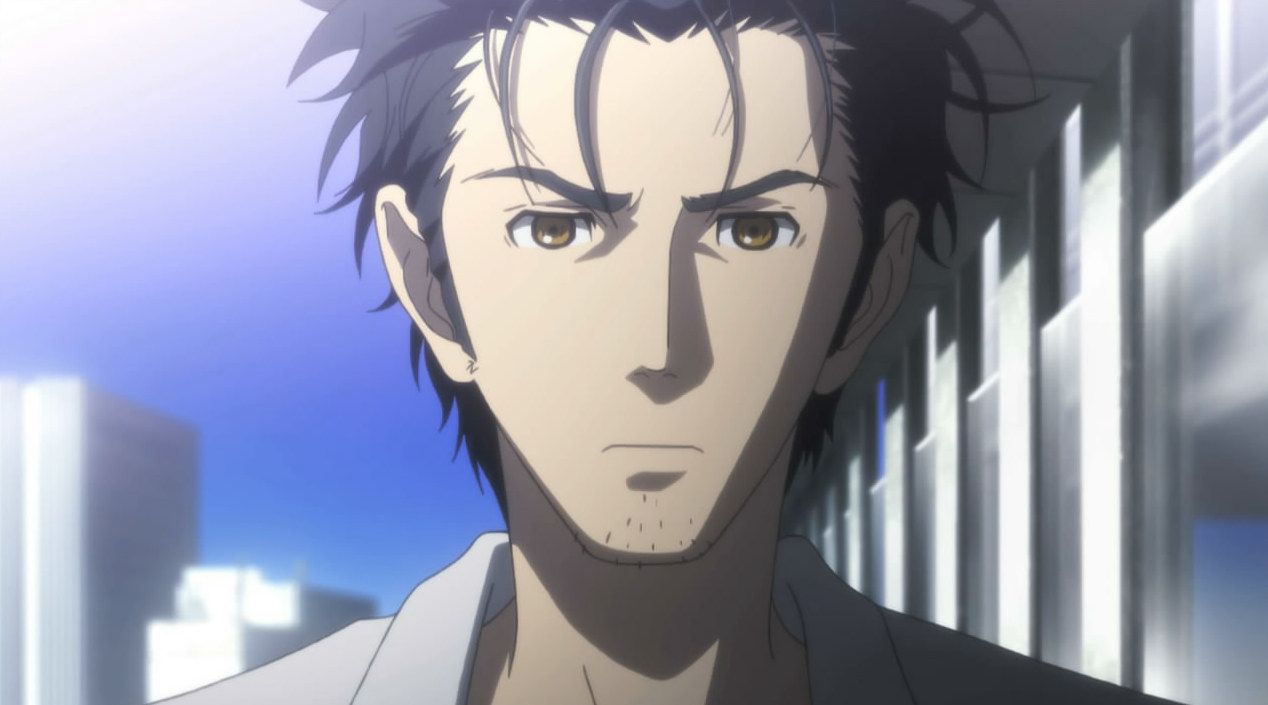
This specific worldline is not connected to any attractor field and is known to be rare.
It created a double helix with R-World Line and was seen from time to time during Steins;Gate: The Movie – Load Region of Déjà vu.
These are the main events that happened in this worldline:
- Moeka was fired from Arc Rewrite but Tennouji accepted her as a part-timer
- Nakabachi stabbed someone and Kurisu reported it
- Moeka and Okabe looked for IBN5100
- PhoneWave was dismantled
- Nakabachi’s paper got burned and he was arrested in Russia
- Okabe and Kurisu reunited in Akihabara
- Kurisu sent a mail to Okabe on his birthday
- Okabe received a letter from Kurisu
- Kurisu met Kunosato Mio and then went to the Viktor Chondria University Institute of Neuroscience

- SERN was able to freeze time machine development research. It then transitioned to BHB bomb development.
- The New Generation Madness returned
- Kunosato Mio requested refuge and Daru approved
- Amane Suzuha was born
- Nae joined the JAXA Chofu Aerospace Center and abducted the robot research club members of Chuuou Tanegashima high school
- BHB was stolen
- Nae decided to rescue Frau Koujiro
- Daru gave the DG297 3rd edition ver.4.11
In Steins;Gate , it is important to note that each worldline is called an attractor field, which is basically a cluster of worldlines that lead to one single event.
Even if each worldline is different from the others, every worldline will still move in the same direction.
Get the latest news and trends direct to your feed by following us on Twitter @epicstreamanime or on Facebook .
READ NEXT: The Best Anime Based on Visual Novels
Explore new topics and discover content that's right for you!
See Games Differently
Subscribe to our newsletter!
Now you can get the top stories from Kotaku delivered to your inbox. Enter your email below.
By subscribing you agree to our Terms of Use and Privacy Policy.
The Massive World Of Steins;Gate, Explained

But if I’m going to try to explain the Science Adventure series, I’m going to need someone to ask all the stupid questions and make me seem even more intelligent and knowledgeable than I already am.
This story originally appeared in January 2016, and has been reposted to coincide with Steins;Gate 0’s PC release this week.
…Hey! Disembodied voice that haunts me (and occasionally Fahey), that was your cue!
::Sighs:: Not even trying to be civil anymore, are we?
Oh, come on. We may have come to loathe each other over the course of these explainers, but it’s fun to learn new things. Besides, it’s not like you have a choice.
… Fine. Let’s get on with it.
That’s the spirit.
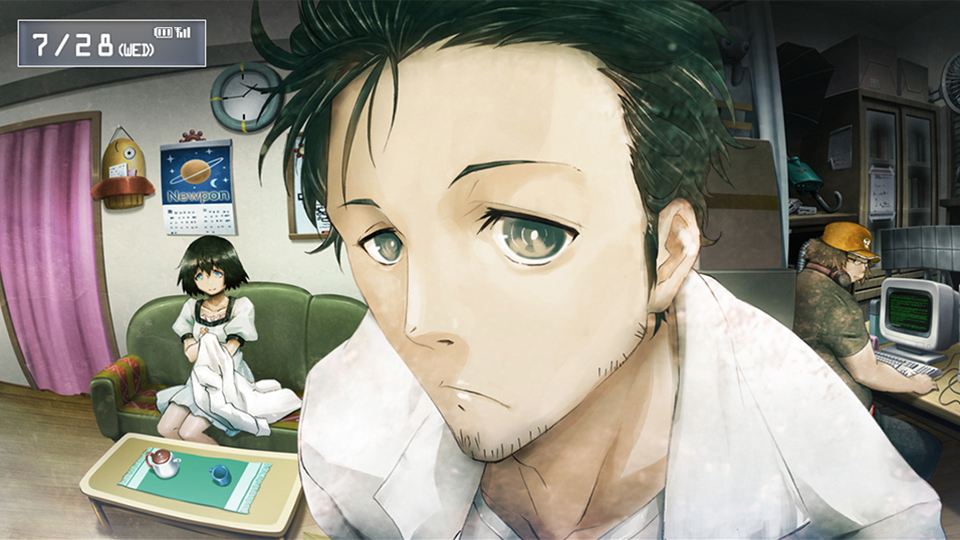
Alright, so what is the Science Adventure Series?
Made by 5pb Games and Nitroplus, Science Adventure is a series of five core games: Chaos;Head, Steins;Gate, Steins;Gate 0, Chaos;Child and Robotics;Notes .
I see what you mean about the improper use of semicolons .
It’s pretty much the series’ trademark. Anyway, there are also several side stories, non-canon spin-offs – and several special editions of the core games with additional content.
So what ‘ s the pitch? What ‘ s it about?
That’s a complicated question. Simply put, all five main games take place in the same world and are each centered around a core sci-fi concept. The two Chaos games focus on people with reality-altering powers. The two Steins;Gate titles are about time travel.
And Robotics;Notes?
It’s about a group of kids building a realistic Gundam.
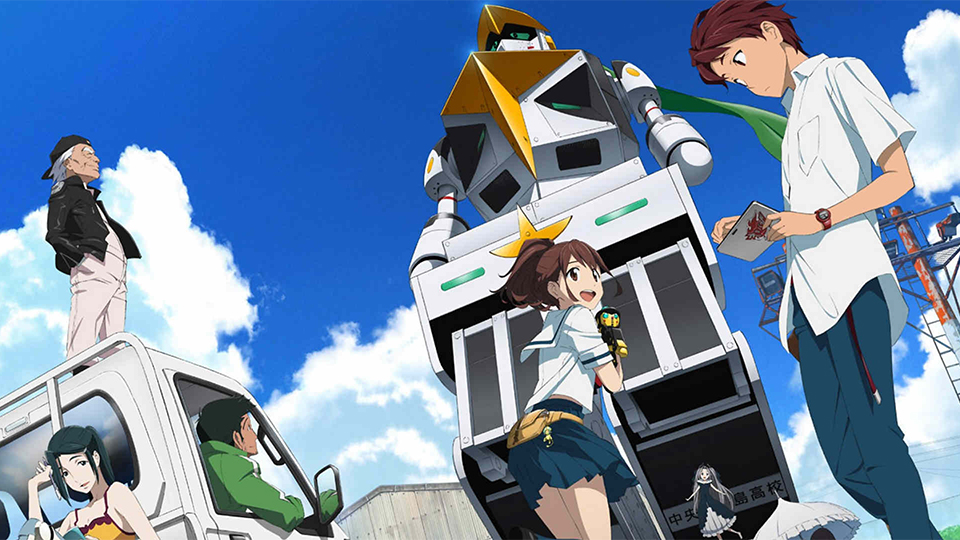
I ‘ m not sure whether I am more excited or incredulous about the idea. And what do you mean by “ realistic “ ?
Well that’s one of the best parts about the series as a whole: There’s actual science in it. In the case of Robotics;Notes , it talks a lot about how the giant robots would be too top heavy for their legs to even support the weight, much less move – stuff like that. Steins;Gate goes fairly in depth into the main theories of building a real-world time machine (and why each wouldn’t work) while the Chaos games deal with the nature of perception, reality and antimatter.
So it ‘ s scientifically accurate?
Oh Christ no! But like the best science fiction, it at least starts in real science before it throws itself headlong into the fiction.
Alright, so far so good. You ‘ ve got my attention. Now what?
Well, let’s break down the series game by game and talk a bit about each. Let’s do them in the series’ fictional chronological order and start with Chaos;Head .
Alright, if you were going to pitch Chaos;Head to me, how would you describe it?
Persona 4 meets Se7en – only way more messed up.
Yeah. Well, anyway, Chaos;Head begins in 2009 and follows a hardcore anime otaku (and borderline shut-in) named Takumi who lives in a cargo crate on the top of an apartment building in Tokyo’s Shibuya District (the same area as in The World Ends With You ). One day while feeding his off-brand EverQuest addiction, he is sent pictures of a horrific murder – a man impaled to a wall by hundreds of stakes. He ignores it as a prank; but while walking home the next day, he comes across that exact scene – with the addition of a pink-haired girl, stakes in hand.
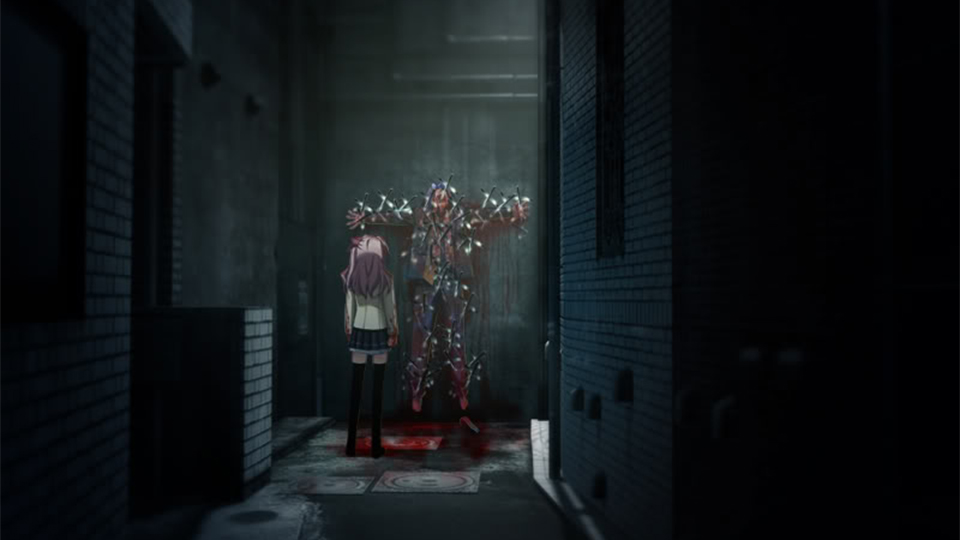
Soon, Takumi finds himself at the center of a series of bizarre serial killings. Suspected by the police while, at the same time, sure that he is the next target, Takumi begins to be overcome by delusions that run the gamut from horrifying to erotic. He tries not to solve the mystery, but rather to escape it.
I assume he does a piss poor job of that.
You could say that. Especially as a stream of strange girls begin entering into his life – changing the very nature of his “2D-only” reality. Soon, he’s not even sure where the delusions end and reality begins.
So, this is a visual novel , right? Is there any gameplay?
Sure. Basically, you are in control of Takumi’s delusions. You choose whether he sees a positive one (comical and/or erotic), is shocked by a negative one (gory or otherwise terrifying), or manages to stay grounded in reality.
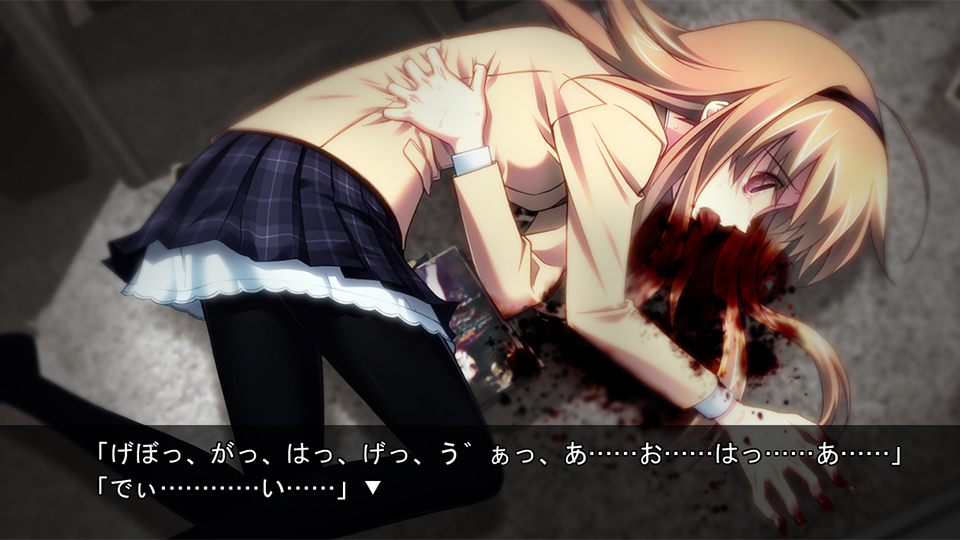
Does this affect the final outcome of the story or anything?
In the new game plus version of the original game it does – though the game only has three endings. In the remastered version, Chaos;Head Noah , his delusions affect a lot more as there are a ton of new routes through the story.
So how is Chaos;Head overall?
Well, it’s relatively short compared to the rest of the series and has a staggeringly unlikable main character. I’m not sure whether you are supposed to sympathise with him or enjoy torturing him. Moreover, the game’s main cast never really comes together as a group – it’s more like Takumi is wandering in and out of their stories than they are a vital part of his. It’s not a bad game by any means – as both the world and plot are gripping – but compared to what comes next, it might as well be nothing.
… Here it comes.
Steins;Gate is simply one of the best visual novels – if not the best – ever made: amazing plot, great characters and emotional moments. It’s a masterpiece of narrative storytelling. I still feel its anime adaptation is the best anime I have ever seen.
Jesus, you ‘ re such a fanboy!
That’s a funny way of spelling “level-headed and objective”.
::Sighs:: Whatever… Let ‘ s get this over with. Tell me about Steins;Gate .
Steins;Gate takes place in 2010 and is the story of Okabe, a university student (read: self-styled mad scientist) living in otaku mecca Akihabara, who accidentally invents time travel.
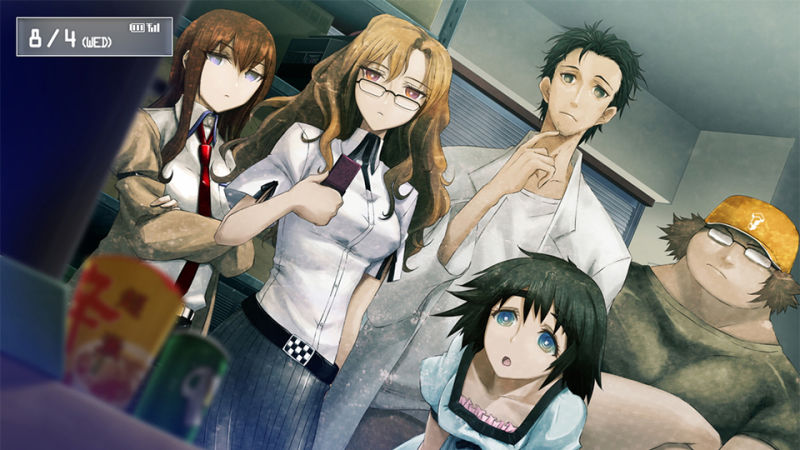
… Well, that was surprisingly succinct .
Oh we are far from done. One day, after a seminar on the subject of time travel, Okabe comes across the recently murdered body of Kurisu – an 18-year-old genius neuroscientist. But when he sends his friend a text about it, the world changes into one where Kurisu is very much alive – not to mention intrigued despite herself by this crazy guy who insists he saw her dead.
Am I sensing a pattern here of these games starting with horrible murders?
Yes. And quiet, you. Anyway, much of the first half of the game deals with Kurisu, Okabe and his friends as they figure out how and what he’s done – that is, sent an email into the past – and how to repeat it. And then there are the various mails they send to improve their lives.
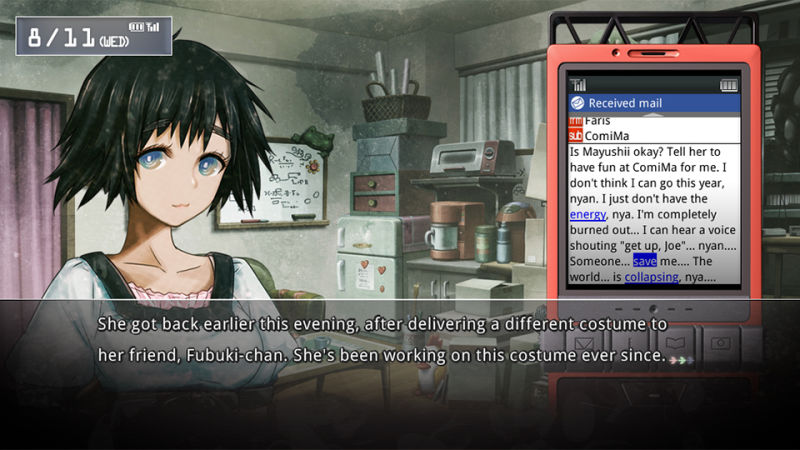
And the second half?
Dealing with the consequences of their actions – and trying to overcome the almost hateful way the multiverse is structured. When it comes down to it, it’s the story of a normal man in a no-holds-barred, knock-down, drag-out battle against fate itself.
So what ‘ s the gameplay like in this one then?
Player interactivity in Steins;Gate is done through Okabe’s cell phone. Responding to messages, making calls and even taking out your phone at certain times can drastically affect how the plot unfolds. In other words, the game changes based on how Okabe interacts with the others and what information he gets at what time.
Huh. So wait, back to the plot for a second. It sounds like Steins;Gate is the beginning of the story. So what is Steins;Gate 0 , then? A prequel?
I can see how the title would lead you to think that, but no. Steins;Gate 0 is actually a midquel – it takes place in the middle of the original’s “true ending”.
Any way to talk about Steins;Gate 0 without spoiling the entire first game?
Sure. Basically, Steins;Gate 0 is the story of Okabe as a broken man. While having achieved his original goal, the price is so high that he is a shell of his former self. Instead of continuing on and fighting for a happy ending, he destroys the time machine and tries to move on with his life.
Haunted by his memories and suffering from severe PTSD, he connects with the colleagues of a dead friend. This in turn leads to a new adventure where Okabe learns that even in a world without time machines, the knowledge that one can be created can be enough to destroy the world.
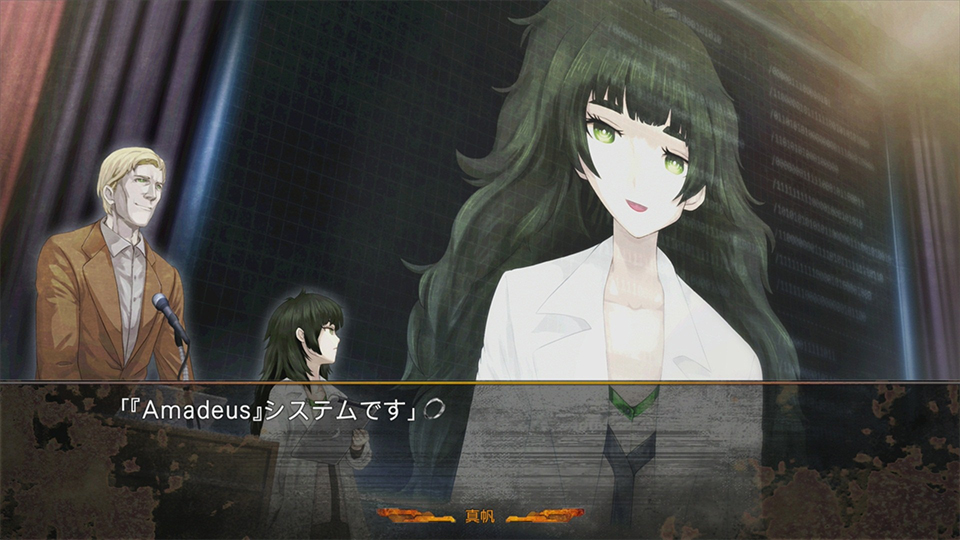
So … what you ‘ re saying is it’s dark.
That’s putting it mildly. However, at its core, it really is a story of redemption – of a man going back to the proverbial battlefield one last time even as the world collapses around him and finding the strength to go on. It’s the missing story showing all that it took to get the original’s “true ending” – which in turn gives the first game’s ending even more emotional power.
Is the gameplay the same as in Steins;Gate ?
Sort of. Both games are controlled by the cell phone. However, what affects this game are key moments where you have the choice to answer the phone or not. What’s interesting is that, despite no time machine existing, both choosing to answer the phone and choosing not to answer the phone causes the timeline to shift in dramatically different ways. There’s no way to stay on the initial timeline. Why exactly this happens is one of the core mysteries of the game.
Yeah, that sounds like a good mystery. So what ‘ s next ? Chaos;Child ? Is that a direct sequel to Chaos;Head ?
More of a thematic sequel, if anything – with all the murders, delusions and reality-altering powers. While the entire cast of Steins;Gate returns for Steins;Gate 0 , only a single supporting character from Chaos;Head physically shows up in Chaos;Child – we focus on a whole new cast instead.
In fact, the characters of Steins;Gate have far more interaction with the story than the Chaos;Head characters when it comes down to it.
I feel like we ‘ re getting way ahead of ourselves here. Back up a bit and pitch me Chaos;Child .
X-Men meets Persona 4 meets Se7en – only way more messed up.
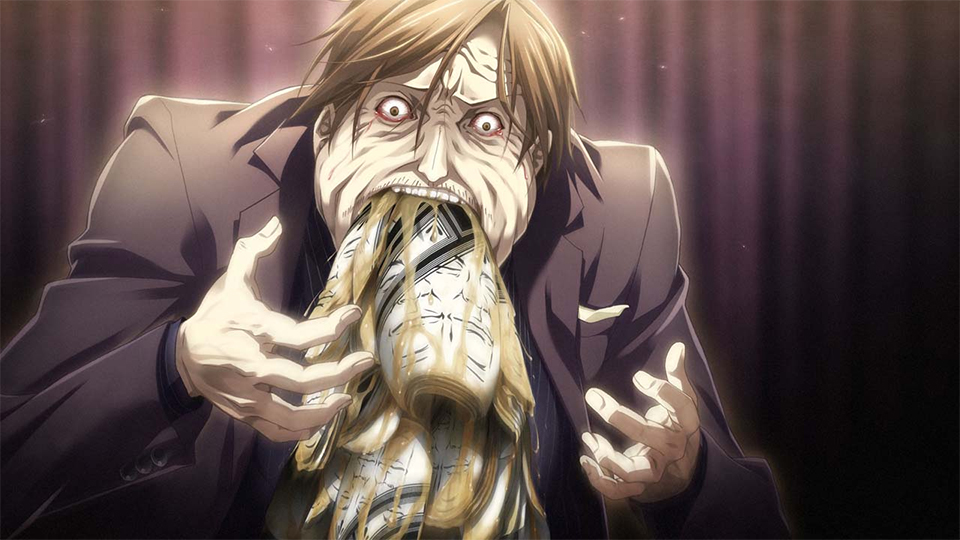
… Alright, this time that description needs explaining, I think.
OK, backing up to Chaos;Head a bit, it both begins and ends with a massive earthquake levelling Shibuya. Chaos;Child picks up in 2015 and follows a group of teenagers who survived the quake as children – though most of their friends and family did not.
The main character this time around is Takuru. While a bit awkward when it comes to the opposite sex – other than his best friend and his sister, anyway – he is far from a shut-in and is the president of his high school’s newspaper club.
Still waiting for the X-Men m eets Persona 4 meets Se7en connection.
Basically, he is the first to notice that two recent, gruesome murders happened on the same dates as the serial killings in Chaos;Head . Soon he figures out the pattern behind the victims and discovers that he and many of his friends are possible targets. With this, it becomes a cat and mouse game. Can he catch the killer and save his friends before the next murder date comes to pass?
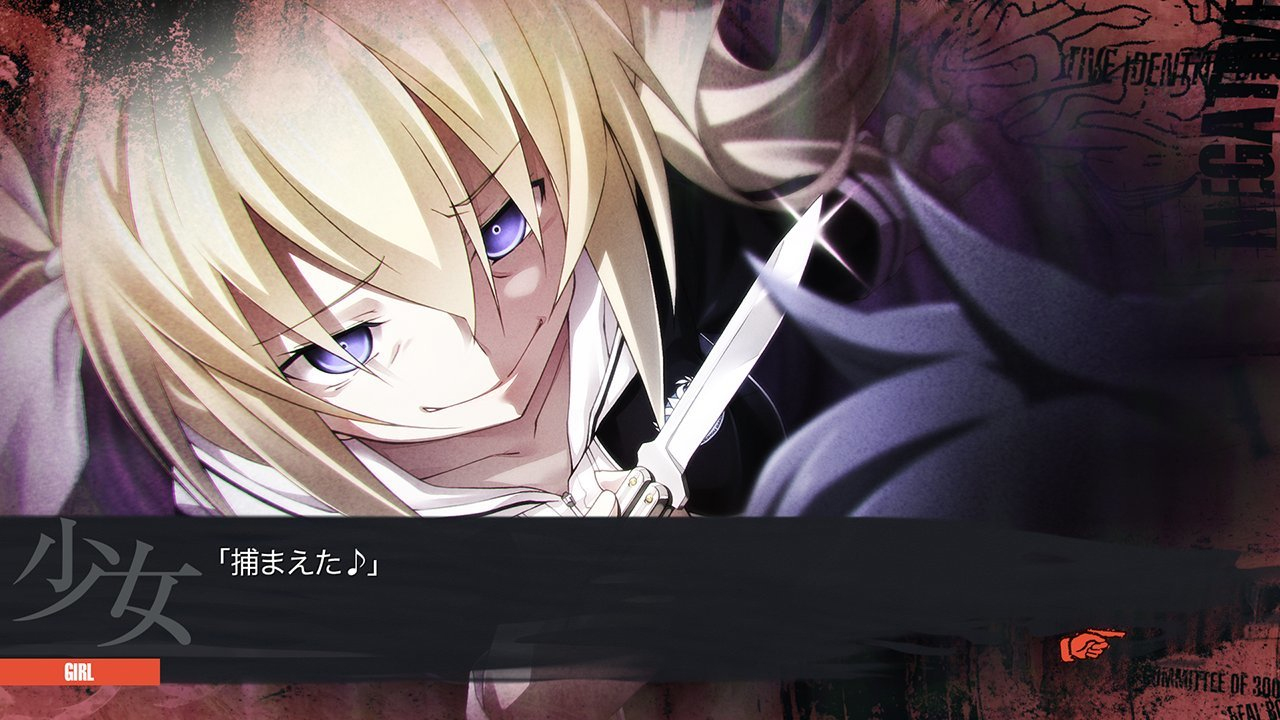
And the X-Men thing?
Unlike in Chaos;Head where several characters have massive, reality-altering powers, the characters of Chaos;Child have a lesser form of the power. For one character it manifests as the ability to detect with 100 per cent certainty when someone is lying. For another, it’s full-blown pyrokinesis.
Superpowered teens solving a murder mystery. Got it. How ‘ s it play?
Identically to Chaos;Head for the most part, with you choosing which delusions Takuru sees or if he stays in reality. There’s also a bulletin board with a map of the area which you return to time and again. You use it to sort out all the evidence you’ve gathered and pick the correct conclusions to continue the story.
There are also several different routes to the story that change based on the delusions you see – though this only happens after you beat the game once.
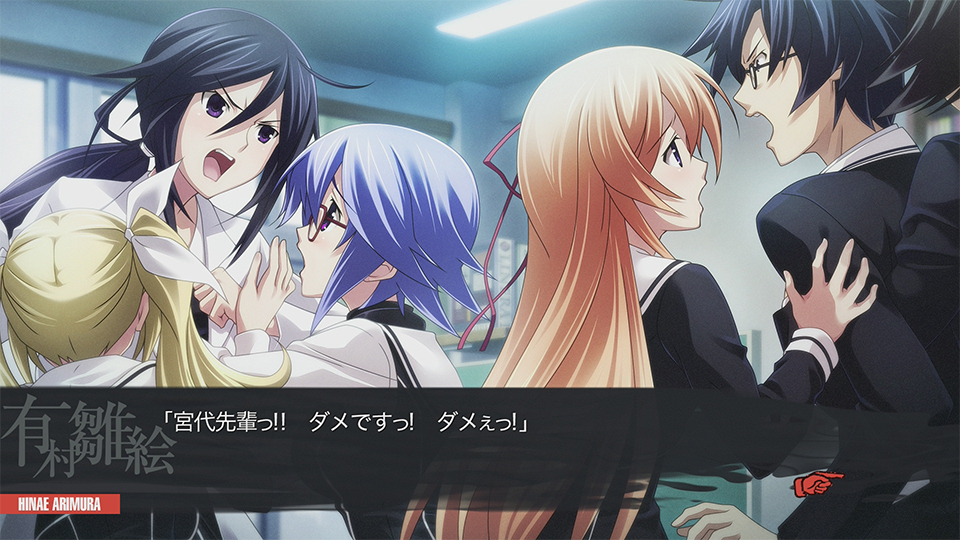
But is Chaos;Child any good?
Actually, it’s fantastic. It’s just below Steins;Gate in terms of story and characters and is way better than Chaos;Head . Some of the various routes through the story feel like either pure filler or are world-breakingly over-the-top, but the two or three core routes are just brilliant. It’s a great mystery with equally great pay off.
Anyway, that brings us to –
You promised me Gundams.
– Robotics;Notes .
::Sighs:: Robotics;Notes is set in 2019 on the Japanese island of Tanegashima – which serves as one of JAXA’s (the Japanese NASA) launch sites. It follows a group of kids in their high school’s robotics club. The main character is Kaito, a hardcore fighting gamer who is hard pressed to do anything else. His best friend, Akiho, however, has a dream: to build a giant robot.
Well a “Gunvarrel”, but yeah, OK. A Gundam. Anyway, building it gets them involved in several mysterious occurrences: secret reports that hint of an impending apocalyptic conspiracy, monopoles literally falling from the skies, robotics malfunctioning with lethal results and an AI girl who likes to talk about the weather.
…You know, when you write it all out like this, Robotics;Notes is really weird.
I can see that.
Anyway, it plays similar to Steins;Gate , though Kaito uses an Android pad instead of a phone and can use its apps to affect the plot.
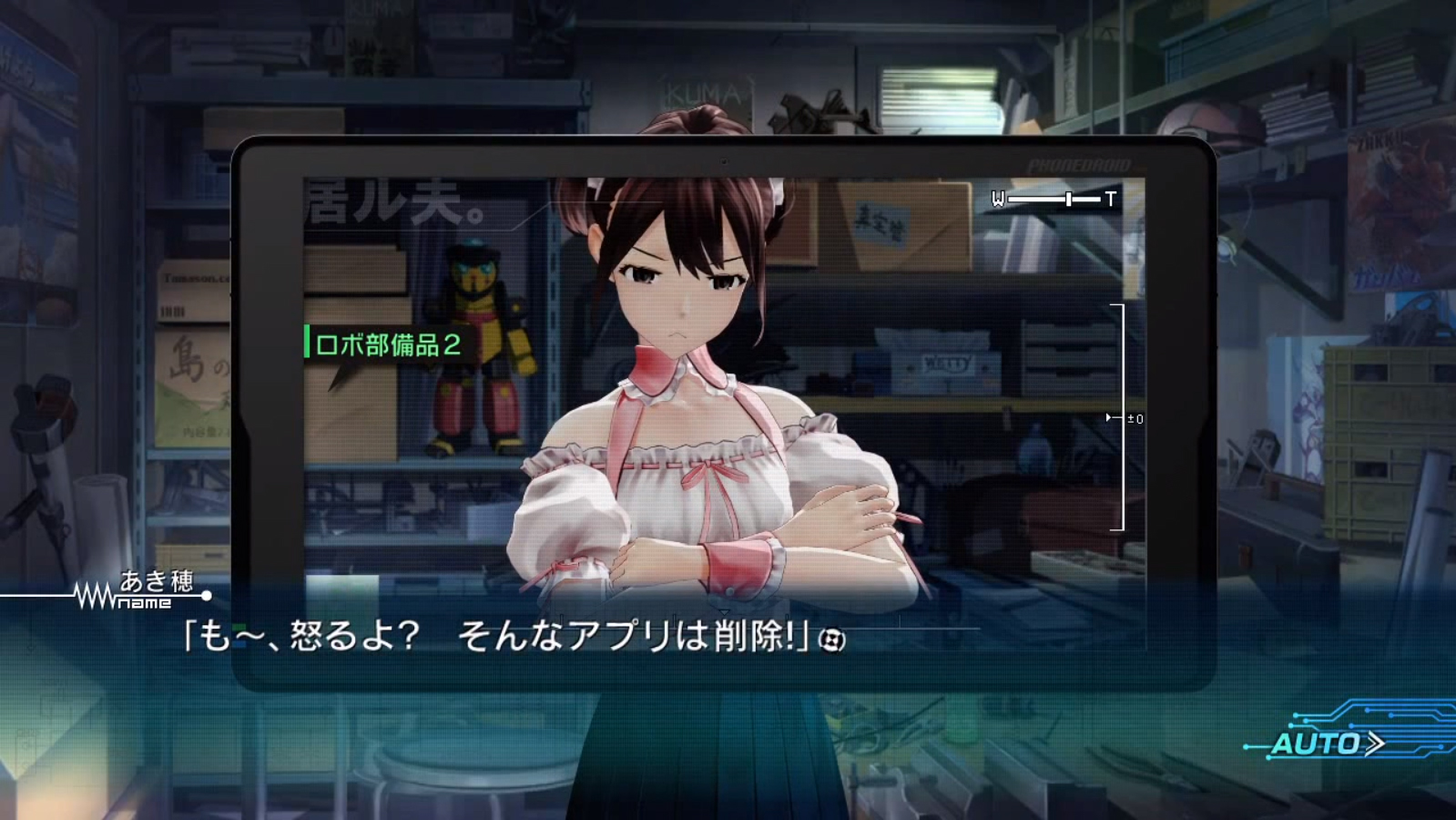
And the verdict?
Full confession, I have only seen the anime for this one (and rewatched it for this article) but have yet to play the game. So while I know the main story, I don’t know all the game-only routes.
That said, it’s… OK. It has some really great parts – especially the climax – and several of the characters are fantastic. But it kind of feels like it suffers from the shotgun approach to storytelling: do enough plotlines and some of them will hit home.
OK … So that ‘ s all the main games , right? Even after all that (beyond the obvious sequels) , I don ‘ t see how these games with time travel, reality-altering powers and robotics are all related other than being in the same world.
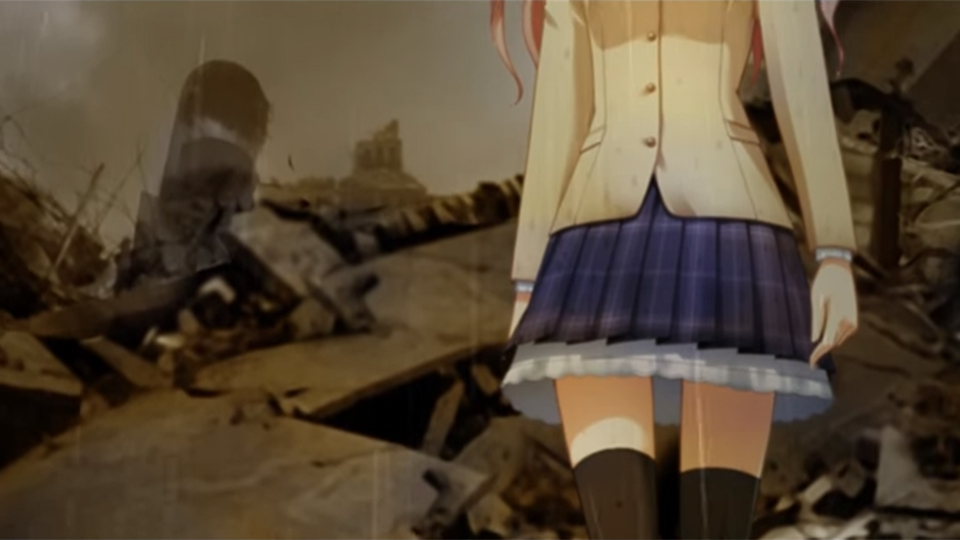
Basically, the thing that ties all the games together is their villain. Lurking in the background of each is the Committee of 300. Based on the real world conspiracy theory of the same name, the Committee of 300 seeks world domination – and while they already have enough money and power to get away with murder (literally), they want complete control.
I see. Like say, over time .
Or over reality itself.
Or … Gundams … ?
The giant robots are more of a means to an end than the end itself.
I ‘ ll take your word for it.
Man, Robotics;Notes is so weird.
I ‘ m getting that vibe.
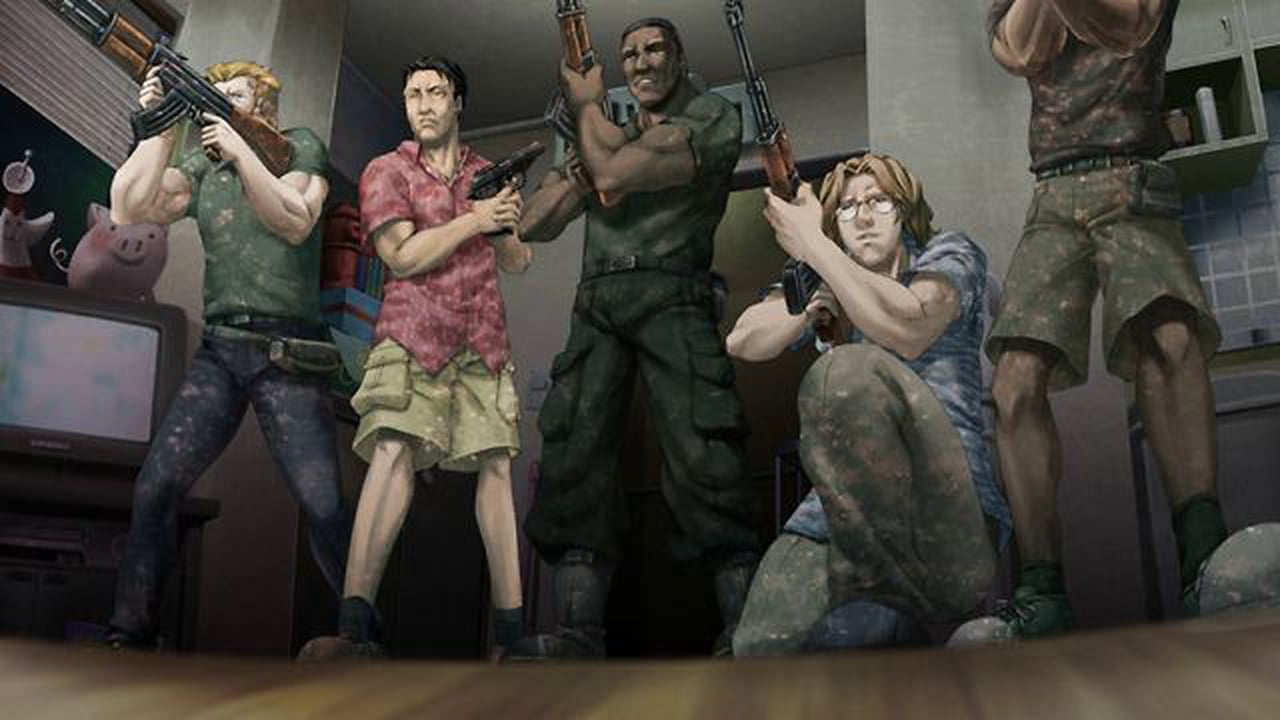
But anyway, Committee of 300 proves to be a great villain. They control corporations, political parties and religions – really, anyone you know could be an agent of theirs. They’re so massive that even when the heroes have a time machine or superpowers, the Committee still seems unbeatable. Moreover, most of the time, they don’t even seem to care that our heroes exist and let them run wild – until the moment they suddenly (and lethally) change their minds anyway.
Alright, so you ‘ ve sold me. Where can I play these?
Well, there’s the issue…
Break it down for me.
- Chaos;Head has never been officially released in English – though there is an anime adaptation of it.
- Steins;Gate has both an official English release and a fantastic anime .
- Steins;Gate 0 is new and has neither – though there is a special anime lead-in episode for it that aired along with the game’s Japanese release.
- Chaos;Child is in Japanese only, but it will be getting an anime in mid-2016.
- Robotics;Notes is also Japanese only; however, it has an anime adaptation.
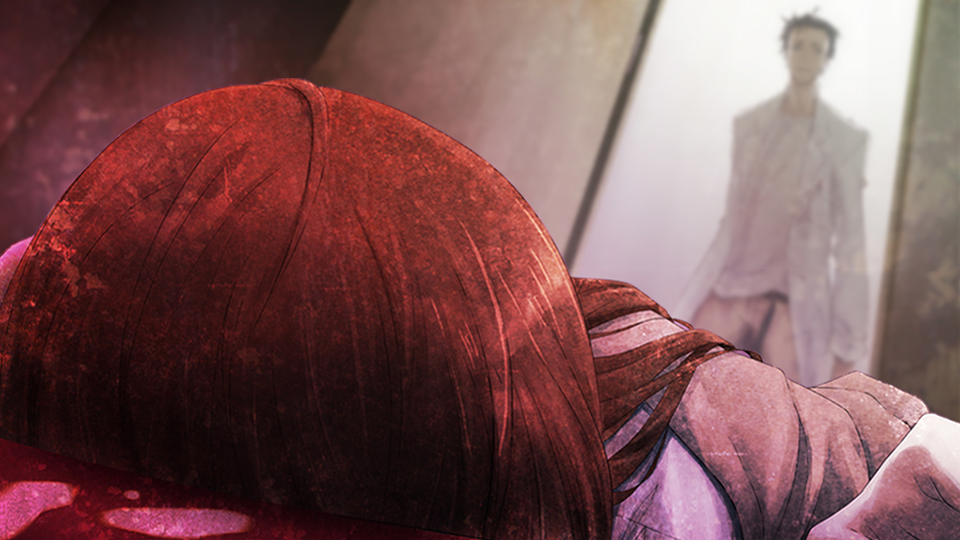
The Cheapest NBN 1000 Plans
Looking to bump up your internet connection and save a few bucks? Here are the cheapest plans available.
6 responses to “The Massive World Of Steins;Gate, Explained ”
Great article, I didn’t realize all of these were linked and shall proceed to watch some of the others. I adored Steins;Gate when I finally 100% finished it on Vita recently.
El Psy Congroo.
How faithful/complete are the anime versions of these games? Would you say that whatever was inevitably cut is worth going through the trouble of getting the games and the fan translations?
From what I’ve played of the VN, Steins;Gate is very close
How about Occultic;Nine?,.any new update on this (g)old articles?
If you like the style of the Science Adventure games/anime/manga/media, I highly recommend the manga Purple the Qualia.
I agree. Steins;Gate is #1.
Advertisement
Quantum time travel: The experiment to 'send a particle into the past'
Time loops have long been the stuff of science fiction. Now, using the rules of quantum mechanics, we have a way to effectively transport a particle back in time – here’s how
By Miriam Frankel
29 May 2024

Ryan wills/istock/Amtitus
When Seth Lloyd first published his ideas about quantum time loops, he hadn’t considered all the consequences. For one thing, he hadn’t anticipated the countless emails he would get from would-be time travellers asking for his help. If he could have his time over again, he jokes, he “probably wouldn’t have done it”.
Sadly, Lloyd, a physicist at the Massachusetts Institute of Technology, won’t be revisiting years gone by. Spoiler alert: no one will go back in time during the course of this article. But particles? That is another matter.
Theoretical routes to the past called time loops have long been hypothesised by physicists. But because they are plagued by impracticalities and paradoxes, they have been dismissed as impossible for just as long. But now Lloyd and other physicists have begun to show that in the quantum realm, these loops to the past are not only possible, but even experimentally feasible. In other words, we will soon effectively try to send a particle back in time.
Rethinking reality: Is the entire universe a single quantum object?
If that succeeds, it raises the possibility of being able to dispatch, if not people, then at least messages in the form of quantum signals, back in time. More importantly, studying this phenomenon takes us to the heart of how cause and effect really work, what quantum theory means and perhaps even how we can create a successor theory that more fully captures the true nature of reality.
In physics, time loops are more properly known as closed time-like curves (CTCs). They first arose in Albert Einstein’s theory of general relativity…
Sign up to our weekly newsletter
Receive a weekly dose of discovery in your inbox! We'll also keep you up to date with New Scientist events and special offers.
To continue reading, subscribe today with our introductory offers
No commitment, cancel anytime*
Offer ends 2nd of July 2024.
*Cancel anytime within 14 days of payment to receive a refund on unserved issues.
Inclusive of applicable taxes (VAT)
Existing subscribers
More from New Scientist
Explore the latest news, articles and features

Liquid crystals could improve quantum communication devices

Quantum sensor gets a read on tiny worm implanted with nanodiamonds
Subscriber-only

Atoms at temperatures beyond absolute zero may be a new form of matter

Glitching radio waves from dead stars explained by swirling superfluid
Popular articles.
Trending New Scientist articles
Reading Steiner
- Edit source
Reading Steiner is the name that Okabe gives to his rare ability to remember the events of other world lines . In theory, when a world line shift takes place, everything is reconstructed to match the new active world line, including people’s memories. However, Okabe’s mind is seemingly an exception to this rule, allowing him to retain knowledge of the world’s genuine history.
This quality is also not entirely unique to Okabe. Many more people, perhaps everyone, can remember other world lines to some extent. These memories manifest in dreams, or feelings of déjà vu. [1]
Full Reading Steiner [ ]
Strictly speaking, what Okabe calls Reading Steiner is the particular sensation he feels when a measurable divergence change takes place. According to his narration, this is:
Slight vertigo. As if my feet are off the ground. My vision blurs as if I had been thrown into the ocean. Everything in sight turned monochrome. Did the ground shake? Physiological feelings of fear. Instinctive feelings of fear.
Mayuri : "Okarin? What’s wrong?" Mayuri’s calling voice snaps me to my senses. I notice that color has returned to the world. — Chapter 3, Steins;Gate
There are other points where Okabe retains his memories, but does not feel this sensation, such as when a change to the past is too small to alter the divergence meter reading.
The Reading Steiner sensation takes place when the world line changes in the Present , as a result of a D-Mail or present day change, so coincides with the moment of world line reconstruction . Its effect is to maintain Okabe’s present memories, effectively copying them onto the new world line .
In terms of the larger world line structure, Reading Steiner also makes changes to inactive world lines. Just as a D-Mail or present day change arrives on all inactive world lines that are consistent with it, so too do Okabe’s memories from the moment of making that change. The D-Mail arrival and Reading Steiner arrival are inseparable. Those modified world lines will evolve as time progresses, although being inactive, no divergence-changing events will take place.
This explains how characters on a certain world line can recognise Reading Steiner as something that Okabe has displayed previously, even though that event happened prior to the world line ever becoming active. [1]
Déjà Vu [ ]
Everyone has the ability to remember other world lines to some extent, which manifests as dreams or feelings of déjà vu. [1]
Okabe : "I thought memories couldn’t be shared between world lines. I thought my Reading Steiner was special. But maybe that isn’t true. Maybe everybody has the same power as me, but to varying degrees. It might even be to the point where it can’t be called a power." — Chapter 10, Steins;Gate
Precisely what triggers this is not specified. Often, déjà vu memories are of events that a person experienced on a previously active world line, but forgot due to reconstruction. (For example, female Luka remembering being male.) It is also possible for people to recall events that happened to other iterations of themselves, from before time travel moved the present back and led to different events. (For example, the Okabe of the Steins;Gate 0 anime remembering the USSR world line experienced by an earlier version of himself.) [1]
Other Manifestations [ ]
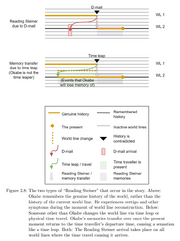
Votuko — Mechanics of Steins;Gate [1]
As mentioned previously, there are other cases of memory retention between world lines that do not cause particular sensations. One instance happens when a world line shift takes place, but its divergence change is too small to register on the meter . Here, Okabe retains his memories of the previous world line, but does not feel the shift taking place.
Physical time travellers are another such case where memories are retained, but the specific Reading Steiner sensation is not felt. This is because objects moving between world lines , like D-Mails or time machines, are not subject to the reconstruction that their arrival triggers. [1]
Titor : In the case of physical time travel, memories are conserved even if the world line changes. That’s been proven by my very own experience. — Chapter 3, Steins;Gate
It is also notable that Okabe does not experience Reading Steiner when time leaping , or when he returns to the moment that a time leap was sent from. If time leaping acted identically to D-Mails, then we would expect the current Okabe’s memories to be overwritten by the Okabe who pressed "send" on the time leap. But this does not happen. The universe recognises the Okabe who arrives in the past as the genuine one, supporting the idea that unlike D-Mails, time leaping does move the Present .
A unique type of memory retention occurs in Luka’s ending. Here, Luka uses the time leap machine to change the world line by a small amount, causing a divergence shift in the past from our Okabe’s perspective. Instead of experiencing the usual Reading Steiner sensation (or nothing), he experiences a sensation like a time leap. [1]
Okabe : My entire body goes through shock and chills, just like it always does right after time leaping.
“...This is...”
It’s not like I time leaped myself. Nevertheless, I teleported from the lab to Yanabayashi Shrine . Did the world line change...? No, Reading Steiner didn’t activate, so there’s no way the world line changed . — Chapter 8, Steins;Gate
Luka’s time leap must move the location of the Present back, so this is the only example in the story where our Okabe is not around at the moment of world line reconstruction . Other instances of Reading Steiner could be described as Okabe’s experience of his surroundings being reconstructed. But in this case the reconstruction took place some time earlier, and all that happens from Okabe’s perspective is that his memories of the previous world line overwrite his memories on the new one. [1]
On many Beta World Lines , the general population unknowingly experiences notable Reading Steiner. On 1.382733β, this ability is referred to as President's Disease, as those with this ability remember Puchin as the President of Russia instead of General Secretary of the Soviet Union. On other world lines of the Beta Attractor Field, Reading Steiner is minimal and treated as a new form of encephalitis.
Other relevant characters have been known to experience stronger forms of Reading Steiner due to Okabe's involvement. As a result of some sort of reflection, they seem to regain fragments of these memories occasionally.
- On 0.409431α, Faris NyanNyan remembers her D-Mail from 0.456903α that prevented her father 's death and transformed Akihabara after escaping the Viral Attackers, after being talked through events with Okabe's assistance,
- On 0.456914α, Luka Urushibara remembers her first meetings with Okabe on various other world lines as a male, after Okabe assists by prompting a discussion surrounding their meeting.
- On 0.571046α, Mayuri Shiina visits her grandmother's grave, explaining to her granny that she remembers "nightmares" in which she dies in a multitude of ways. Her Reading Steiner is depicted as strong as she is able to remember these events without Okabe's assistance, rather her recollection comes from his involvement in trying to prevent said deaths.
- On 1.129848β, Katsumi Nakase is able to vaguely recall Mayuri's death from various world lines as a "dream" of sorts. Her Reading Steiner is depicted to be strong as she recalls these events without Okabe's assistance, rather her recollection comes from Okabe in these iterations prompting reflection in the form of a short-lived hypothetical.
- On 1.048596% , or the "Steins Gate" World Line, Kurisu Makise instinctively recalls Alpha World Line memories midway through an interaction with Okabe, bewildering even herself mere seconds later.
- In 1.081163β, Amadeus Kurisu seemingly inherits memories from a prior world line immediately before its deletion, somehow knowing about both Steins Gate and Hououin Kyouma.
- The movie Steins;Gate: The Movie - Load Region of Déjà vu features Reading Steiner as an important plot element, as Kurisu and Mayuri use recollection of the pre- Steins Gate world lines to piece together information about Okabe.
- In popular culture, the Mandela effect is similar to Reading Steiner.
- ↑ 1.0 1.1 1.2 1.3 1.4 1.5 1.6 1.7 Votuko — Mechanics of Steins;Gate
- 1 Rintaro Okabe
- 2 Mayuri Shiina
- 3 Suzuha Amane

IMAGES
VIDEO
COMMENTS
There are many different theories for time travel. Steins;Gate uses the black hole theory mostly, by compressing the data of the brain (2.5 petabytes[1]), to a size sendable by the PhoneWave (name subject to change). In the visual novel, Kurisu mentions that although there are many theories, 11 of them are widely accepted in the scientific world. A neutron star is a type of stellar remnant ...
A time loop paradox at the end completes an idyllic use of time-travel as a narrative tool and gives a closure some consider fan pandering. Regardless of that, Steins;Gate puts the study of time ...
Steins;Gate is without a doubt a masterpiece. I have a huge admiration for how well the Steins;Gate time travel story fits together. Time travel seems to be ...
Basically the concept is, every time you alter the past even in the slightest way, multiple timelines will depart, depending on the travelers' free will. Timelines depart on each "tick" of free will, that is, every time a free will is having an effect. In your scenario, on timeline A, Okabe did not send the message.
Steins;Gate goes above and beyond to fill in as many loopholes as it can while laying out the inner workings of the time-travel theories it is based upon. These are a combination of the butterfly ...
'Steins;Gate' is a fascinating visual novel that offers an unflinching exploration of the effects of time travel on one man's mind and emotions.
Steins;Gate takes place in 2010 and is the story of Okabe, a college student (read: self-styled mad scientist) living in otaku mecca Akihabara who accidentally invents time travel. Advertisement ...
Time-travel theories; Timeline; W World Line; World Line Convergence; World Line Shift; Z User blog:Zeldakasumi/World Line Theory, Divergence, Loops, and Kurisu's Deaths and Salvation; Categories Categories: ... Steins;Gate Wiki is a FANDOM Anime Community. View Mobile Site
El Psy Kongroo.Steins;Gate spoilers all over this video, by the way.Welcome to Anime Science, a new series where we breakdown interesting science fiction con...
A time machine is a mechanical device capable of defying the unidirectional flow of time. Such devices have existed purely as hypothetical constructions until the creation of the first time machine by SERN, and the creation of Future Gadget No. 8, the PhoneWave (name subject to change), by Rintaro Okabe and Itaru Hashida in the summer of 2010. On the Alpha Attractor Field, the creation of the ...
Steins;Gate is a Japanese anime television series created by the animation studio White Fox based on 5pb. and Nitroplus's 2009 visual novel of the same name.The series aired for 24 episodes, from April to September 2011. It is set in 2010 and follows Rintaro Okabe, who together with his friends accidentally discovers a method of time travel through which they can send text messages to the past ...
May 27, 2023. Introduction. Steins;Gate, an enthralling visual novel and anime series, has captivated audiences worldwide with its intricate plot and mind-bending concepts. Central to the story is ...
Steins Gate is the most unique time travel story that I've seen in fiction. To understand why, we have to delve into how time travel works and how Steins Gat...
Steins;Gate Is Based on a Real-Life Time-Travel Hoax. Steins;Gate is about a self-proclaimed mad scientist named Rintaro Okabe, who accidentally turns his oven into a time machine. Okabe is a social recluse who runs the Future Gadget Laboratory out of his tiny apartment, but his life takes a 180-degree turn when he stumbles upon the secrets of ...
Steins;Gate is a 2009 science fiction visual novel game developed by 5pb. and Nitroplus. It is the second game in the Science Adventure series, ... prevent Nakabachi from successfully escaping with the time travel theory, and fool his past self, setting him on his journey through time. After this, Rintaro returns to the Steins Gate world line ...
In the Beta Attractor Field, Kurisu Makise was inspired to write a Time Travel thesis. Within, she proposes the various ideas that would later form the basis for a semi-functional time machine used by the Russian government prior to nuclear war. Inspired by her father and John Titor's messages from the year 2000, Kurisu took the thesis she had written to Japan, and confronted her father after ...
By Akil Goin. Published May 9, 2020. In Steins; Gate the eccentric student Rintaro Okabe accidentally emails himself a week into his past with his wacky microwave-o-phone invention. Time-travel experiments ensue. The 25-episode anime was a classic in 2011, and there's an abundance of trivia to emphasize the anime's lasting quality.
Steins;Gate is an anime based on the visual novel by Nitroplus and 5pb. It follows Okabe Rintaro and his friends who learned to time travel by sending text messages to the past to change the present.
Steins;Gate takes place in 2010 and is the story of Okabe, a university student (read: self-styled mad scientist) living in otaku mecca Akihabara, who accidentally invents time travel. Well, that ...
Role in Steins;Gate [] First appearance []. Titor's name appears first in the first episode of the series, when Rintaro Okabe accuses Doctor Nakabachi of stealing John Titor's time-travel theories.Nakabachi's machine uses the same principles as the one described by Titor in the year 2000, so Okabe, a fairly big Titor fanatic, recognizes it right away.
In 2003, the John Titor Foundation published a book, John Titor: A Time Traveler's Tale (ISBN 1-59196-436-9), discussing his claims; the book is now out of print. The 2009 visual novel Steins;Gate, which was adapted into an anime in 2011, heavily features time travel and has John Titor as a major part of the plot.
Physics Quantum time travel: The experiment to 'send a particle into the past' Time loops have long been the stuff of science fiction. Now, using the rules of quantum mechanics, we have a way to ...
Watch STEINS;GATE Time Travel Paranoia, on Crunchyroll. Makise Kurisu was stabbed by an unknown assailant during Doctor Nakabachi's lecture at the Radio Building. But Okabe sees her alive and well ...
Steins;Gate 0 Anime episode 7. 1/2. Reading Steiner is the name that Okabe gives to his rare ability to remember the events of other world lines. In theory, when a world line shift takes place, everything is reconstructed to match the new active world line, including people's memories. However, Okabe's mind is seemingly an exception to this ...